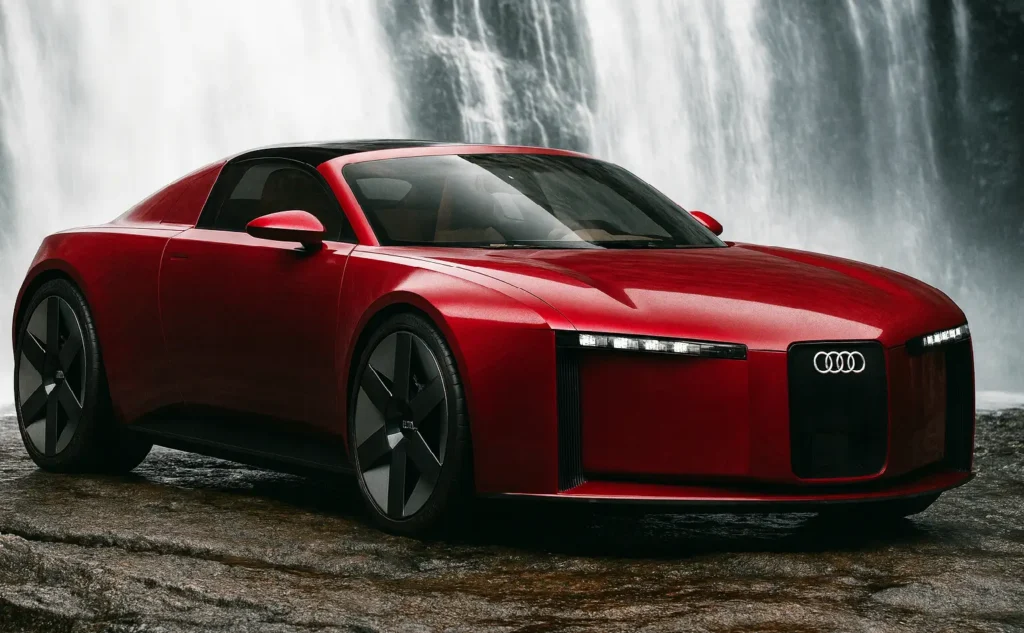From the moment Audi unveiled Concept C, the commentariat rushed to give it one shorthand: “the next TT.” And on the surface, it’s understandable—two doors, compact form, clean surfaces. But here lies the trap. To describe Concept C as TT’s electric replacement is to misunderstand both what the TT became and what Concept C intends to initiate. This is less a continuation than a split, a quiet but deliberate founding of a new sports car lineage defined not by graphics, but by geometry.

TT’s Legacy: Bauhaus to Pixel
When the TT landed in 1998, it was a manifesto on wheels. It stood apart not because of its proportions but because of its language: reductionist curves, circle motifs, and a disciplined adherence to Bauhaus abstraction. Every generation that followed became a design exercise in graphics: from the iconic aluminum vents to the circular instrument binnacle, it wore its lineage on its sleeve with ornament as identity.
But TT’s final decade saw this clarity blur. Pixelated LED clusters, sharp graphics, layered textures—the car shifted from reduction to decoration. What once epitomized restraint morphed into surface spectacle. By the Mk3, the TT was no longer a proportion-led coupé but a digital animation of its former purity. Nostalgia could only sustain it so long.
Concept C’s Ethos: Proportion Over Graphic
Concept C deliberately sidesteps that orbit. Where TT created iconography, Concept C creates stance. Its personality is not in vents or circles, but in balance—the long wheelbase, cab-rearward silhouette, and low cowl. Instead of asking, “What graphic defines me?” Concept C asks, “What proportion moves me?”
This matters. In a brand culture where technological signatures (light graphics, digital cockpits) risk dating faster than they can establish lasting equity, Concept C wagers on timelessness. Reduction here is not minimalism-as-aesthetic, but minimalism as refusal: no ornamental motifs, no callbacks, no graphic gimmicks. It’s sports car design as substance stripped of branding crutches.
Naming Strategy for a New Era
This is why the name cannot, should not, be TT. To call Concept C “TT e-tron” is to yoke it to a nostalgia cycle that undercuts its originality. The TT nameplate evokes not only an icon but also a weight of expectation—curvature as identity, motif-driven interiors, ornamental discipline.
But Concept C signals Audi attempting a different kind of sports coupé: not nostalgia-fueled, not market-pandering, but a return to form-first design. Naming must reinforce that ambition. Concept C should inaugurate a sub-line, the way “Ur-quattro” seeded rally DNA or “Aicon” seeded autonomous thinking. This has the potential to be a pivot, not a reprise.
How to Avoid “Another TT, but Electric”
The danger is perception. The industry and press crave shorthand; Concept C risks being dismissed as “another TT, but updated.” To resist that, Audi has to fight in three ways:
- Design language: Double down on non-iconographic design. Let proportion, stance, and balance be the communicators—not graphic repeats or ornament callbacks.
- Narrative control: Market Concept C not as “heritage reboot” but as “design laboratory,” a rebirth of form as the primary storyteller. Frame its release as the beginning of a lineage, not the continuation of one.
- Product placement: Position it differently. If TT was priced and pitched as accessible aspiration, Concept C should adopt pure design car status: limited, rigorous, deliberately unretro. A halo not of technology, but of restraint.
Because if Concept C is allowed to be branded and understood only as “the next TT,” then its greatest achievement—founding a post-ornament, proportion-led design era for Audi sports cars—will be buried under nostalgia marketing.




